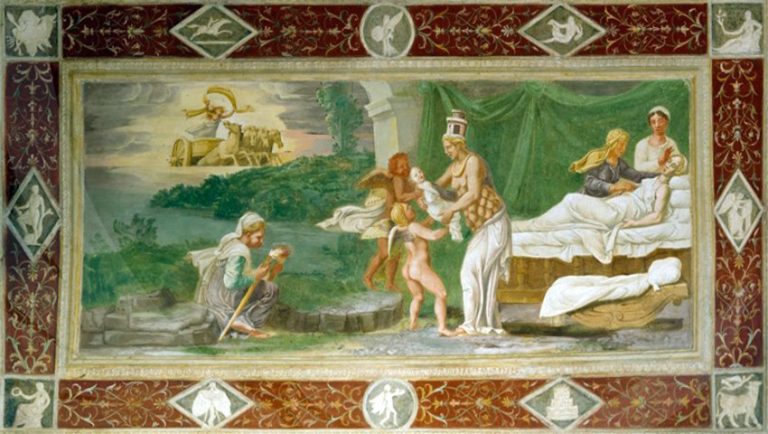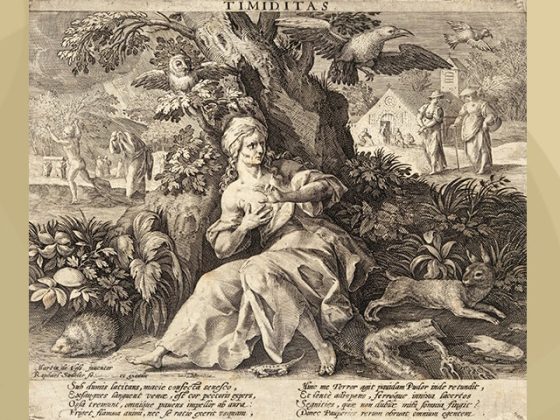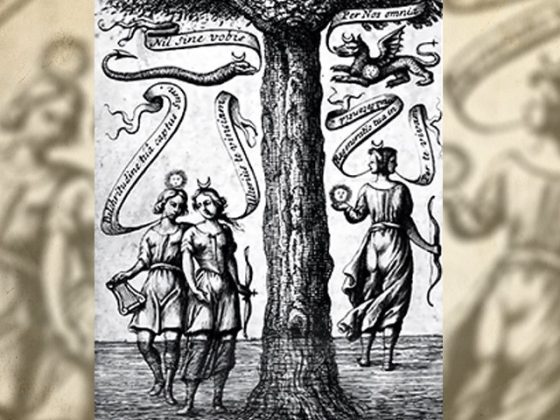Dearest friends:
On this occasion, I am pleased to send you a beautiful image drawn by the Italian engraver Ghisi Giorgo (1520-1582). The source of the composition is a fresco from around 1531 of the Palazzo del Te, the main project of Mantua ─Italy─ by Giulio Romano (1499-1546), Italian painter, architect and decorator.
This engraving is entitled…
…THE BIRTH OF MEMNON
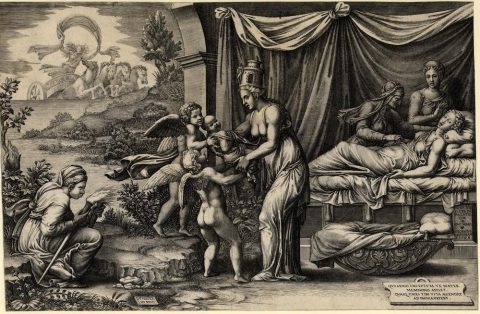
This engraving shows us on the right a woman in her bed who has just given birth. Her baby is received by two Puttis ─two angels─, who receive him from the goddess Artemis of Ephesus ─goddess Diana for the Romans of that time─.
To the left of the engraving we can see a woman with two torches, blowing and passing the fire from one hand to the other.
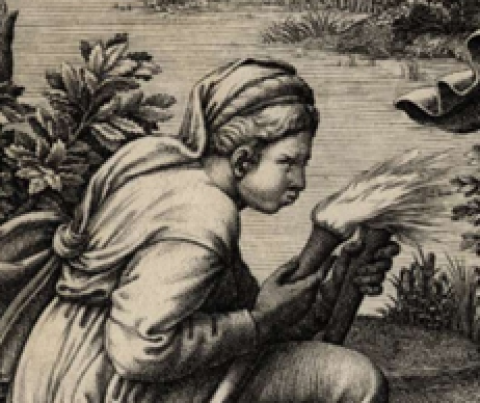
The aforementioned woman feeds that fire with her breath. Why? ANSWER: Because the hierarchies of fire determine good or bad situations according to the karma or dharma that it is necessary to provoke, and therefore the sacred INRI appears in the hands of the lady, who enlivens it with her breath…..
In the background of this beautiful engraving we see Apollo ─Sol Invictus for the Romans, or Helios, the Sun, for the Greeks─ mounted on his solar chariot.
In Greek mythology, Memnon was a king of Ethiopia, son of Tithonus and Eos ─the goddess of the dawn─. During the Trojan War he formed an army for the defense of the city and was killed by the Greek warrior Achilles as revenge for having killed Antilochus. After his death, his mother sent his siblings ─the four winds, those of the north, south, east and west─ to collect his corpse. Eos did not cease to mourn the death of her son all night, and her tears can be seen every cold morning in the form of dew. Moved by Eos' grief, Zeus granted Memnon immortality…..
Analysing the content of this engraving, we must say that it refers to mythology and, as the famous author Mircea Eliade said: “Mythology is the soul of history.” This statement really has a great depth, because behind the myths there are strict explanations that show the original causes of many events that have been lived in the history of our world since remote ages. What is pointed out to us, patient reader, is the constant toil of the Bodhisattvas of Gods or Goddesses experiencing or provoking fabulous or tragic events on the human stage. For this reason, in the case of our engraving, we go to the birth of Memnon, who at the right time is attended during childbirth by none other than the Divine Mother herself, represented by Artemis of Ephesus. There is no doubt that, every time a Bodhisattva is born to determine historical events, the most Blessed Mother is serving as a link between the visible world and that other world we call invisible.
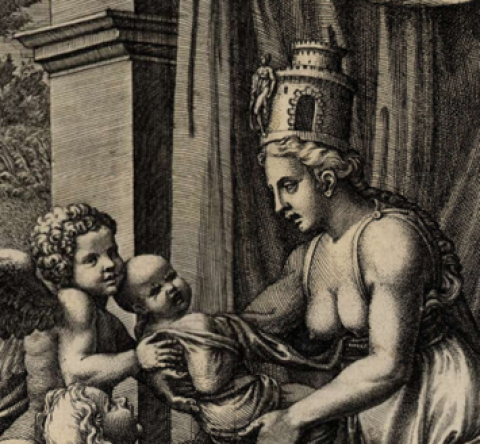
The fact that Memnon is given to the Angels of Life immediately after birth tells us clearly that every Bodhisattva is received into the realm of the existential by the angelic hierarchies, who will help him, in the course of his journey, for the fulfillment of his mission. However, in the same way it is remarked that every Bodhisattva can have weaknesses that can cause his death, even at the hands of another figure who is also of divine or semi-divine nature, such as Ulysses.
This is the eternal struggle that is being waged in the realm of good and evil and, likewise, the permanent combat between forces mixed in the course of history.
On the other hand, we are told that Eos, the mother of Memnon, sent his brothers ─the four winds, corresponding to the four cardinal points─ to retrieve the corpse of her son. Here, then, are the various sacred currents at work to show us that behind great events there are enormous energies moving invisibly, destined to put an end to a cycle of divine activities in order to initiate others that will follow.
It is very timely, esteemed readers, to observe how it is pointed out to us that the tears of Eos are turned into the morning dew in the visible world. This is the mutation or mutations that we witness day after day in our three-dimensional world, without realizing it because of our dormant Consciousness. And, obviously, as it could not be otherwise, in all this multitude of symbols Zeus ─representative of the supreme will of theTheomegalogos─ grants immortality to Memnon in compensation for the sufferings of his mother, the ineffable Eos.
Also, within all that range of mythological characters, it is good to highlight that even great titans like Achilles have a weak point. In his case it was his heel, which was hit by an arrow during one of the confrontations, defeating him and causing him to lose his life. Therefore, in our daily lives, when we want to allude to the weakness of an opponent throughout a confrontation or combat, we say: “The Achilles' heel of so-and-so is such and such a detail of his life….., we must attack there, to defeat him,” etc., etc., etc.
In the background of our illustration we can see the divine Helios ─the Sun, or solar intelligence─ approaching the place of events mounted on his glorious chariot pulled by four steeds. These four steeds allegorize the sacred vehicles which we must possess in our animic nature thanks to the work with our alchemical fires, namely: the etheric body, the astral body, the mental body and the causal body. This is called in the Hebrew Kabbalah the chariot of Merkabah. Some sources compare the same Aurora or Eos, mother of Memnon, to the character of our chariot, due to the fact that it seems that this figure has female breasts. However, on many occasions the gods of Olympus were shown with androgynous characters, having a male and female representation at the same time.
It is obvious that in this case Helios alludes to the solar potentialities that are present at all times in the stellar moments of the human race. This character carries in his hands a cloth or fabric that he brandishes as he approaches the birthplace of Memnon.
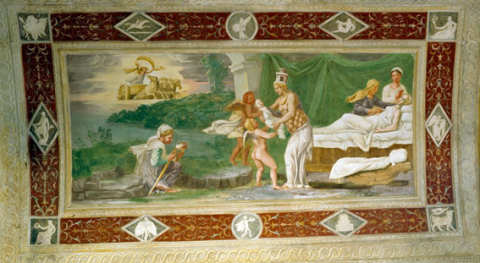
I now give you some sentences that invite us to reflect:
“Adoration is a transcendental admiration.”
Carlyle
“When the heart weeps for what it has lost, the spirit laughs for what it has found.”
Sufi Doctrine
“The true mystic finds God in all religions.”
Ibn Arabi
“Mysticism is not ecstasy, it is much more and better. It starts from the contempt for all things in life, and ends in love for all things in life; contempt lifts us up until we find an ideal that offers us rest, and with the cross of the ideal found we see what was once great and hateful, much smaller and more lovable.”
Ganivet
“Myths are the souls of our actions and our loves. We can only act by moving towards a ghost. We can only love what we create.”
Paul Valery
FINIS CORONAT OPUS.
─'The end crowns the work'─.
KWEN KHAN KHU


